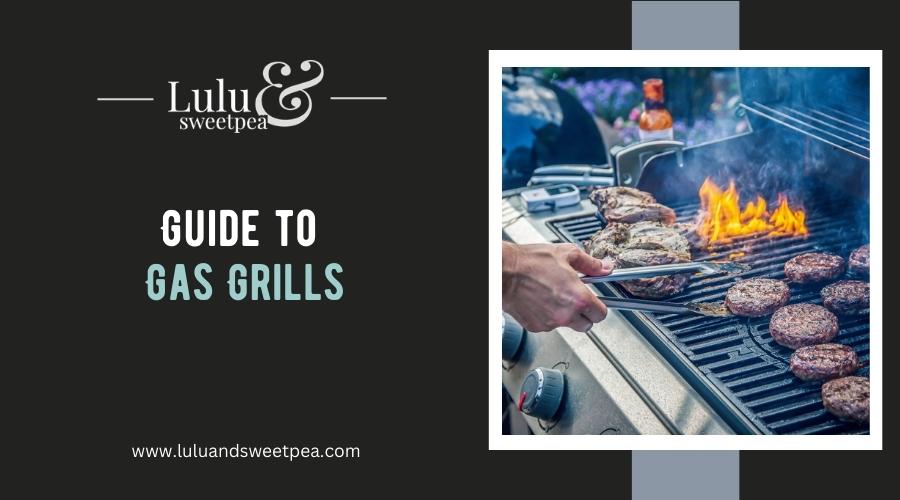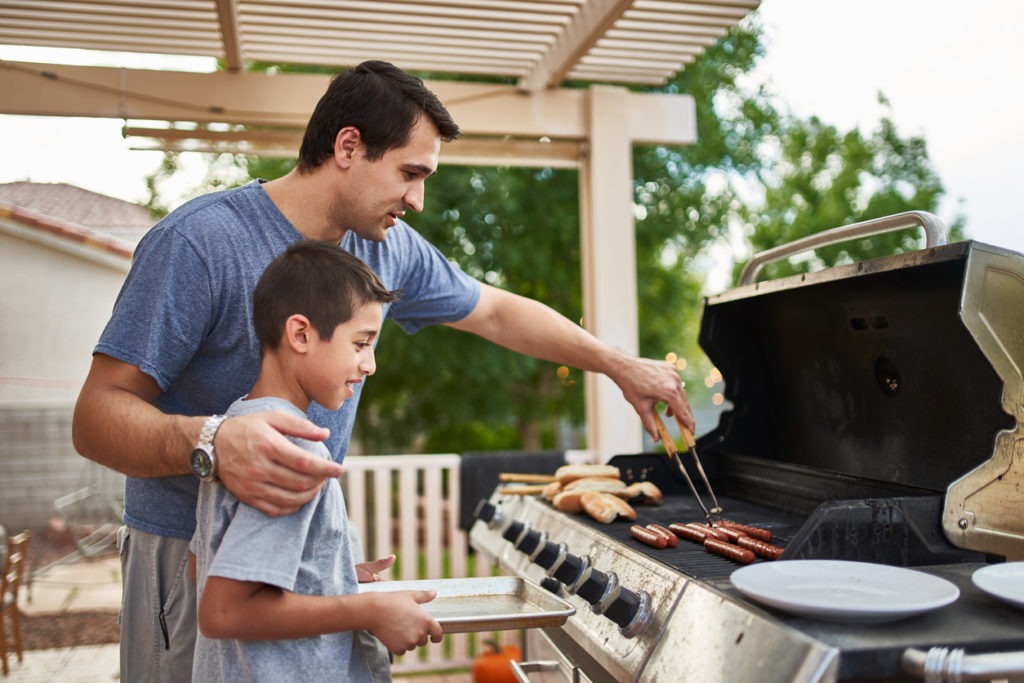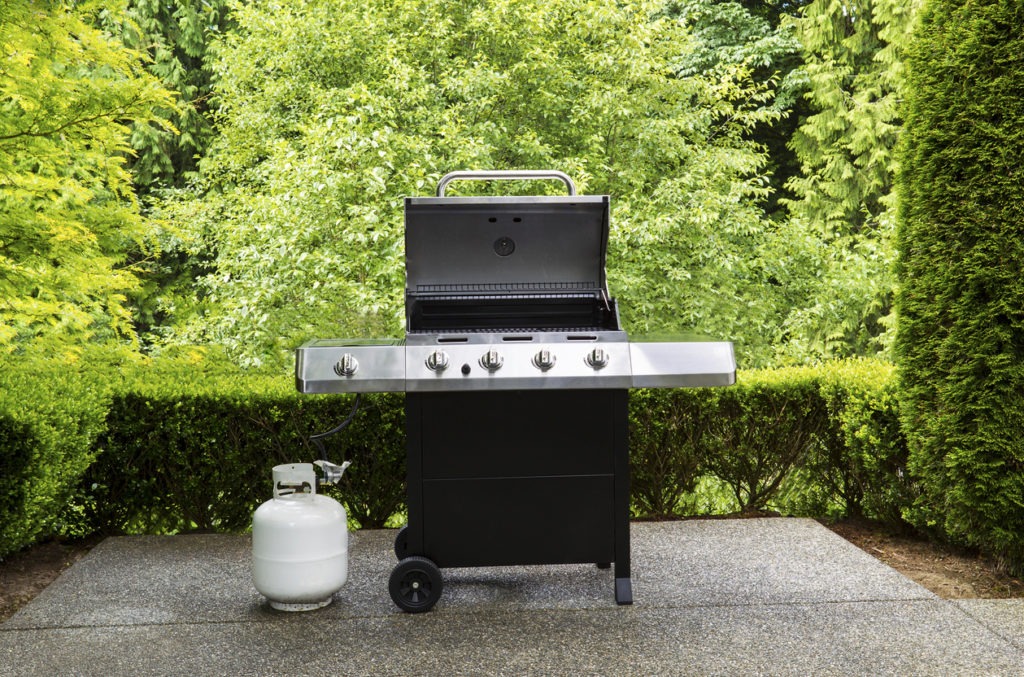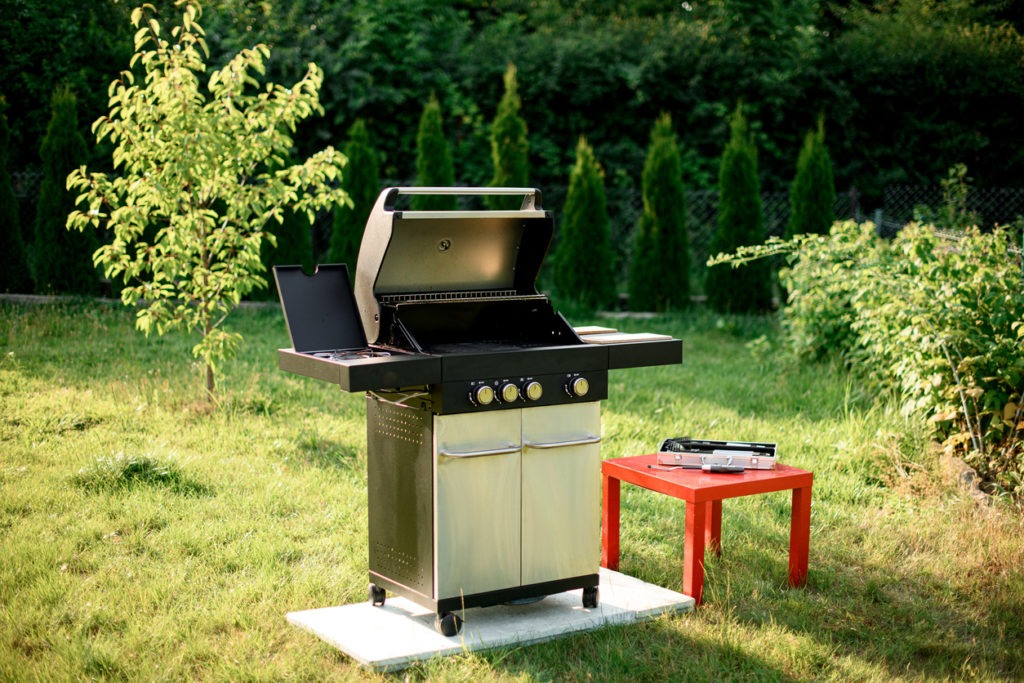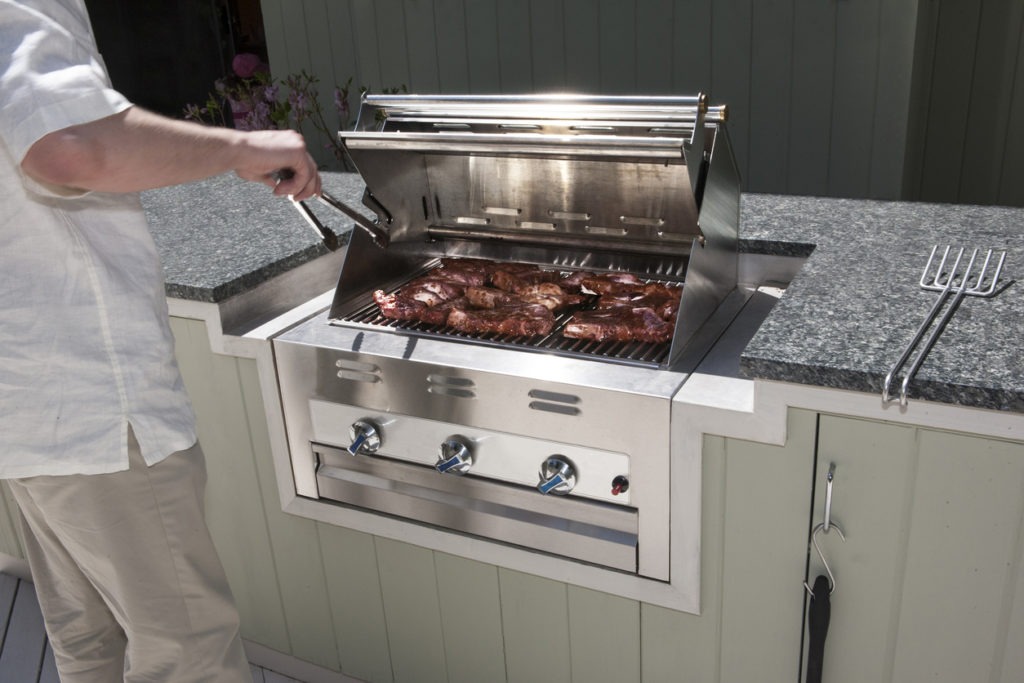Grilling is one of the most popular ways to cook food. The idea of grilling is that you’re cooking food over an open flame or heat source. This allows smoke and flavors from the food to infuse into the meat as it cooks. The result is a unique taste that can’t be replicated any other way!
The problem with grilling is that there are so many options, and it can take a lot of work to know what’s right for you and your needs. That’s why we’ve created this guide to help you find the perfect gas grill for your needs!
Gas grills are a great way to get your grill on regardless of the season. They’re convenient, easy to use, and can make any meal taste like a gourmet meal. But one thing that sets gas grills apart from other types is the ease of use. Charcoal grills are more traditional and have more flavor than gas grills, but if you want to spend less time prepping your food and eating it, then a gas grill is your best friend!
With this guide, you’ll learn about choosing the right grill for your needs, cooking perfect food every time, and even ensuring that it lasts for years without breaking the bank. These tips will help you get started on your own path toward becoming an expert chef with a killer kitchen arsenal.
What is a Gas Grill?
Gas grills are a great option for those who want to grill outdoors without dealing with the hassle and mess of charcoal. They’re a bit more expensive than charcoal grills, but they also offer some benefits that make them worth the extra money.
Gas grills run on propane, a much cleaner fuel than wood or charcoal. This means that gas grills require less maintenance and are easier to keep clean. They also heat up much faster than other grills, which means you can get your food cooked faster than if you were using an electric or charcoal grill.
But that’s not all! Gas grills also have a lot of flexibility in terms of cooking space. Most have at least two burners (or three or four), so they can handle larger pieces of meat or cook multiple things at once. This makes them ideal for tailgating parties and large gatherings where everyone wants their specialty dish (and doesn’t want to wait).
You can also get gas grills that are more portable than other types of grills, so if you have a smaller yard or don’t want to spend a lot of time moving your grill around in the backyard, then this is definitely something worth considering!
So when choosing between a gas grill and another type of grill, think about whether or not these features will be important to your needs—and if they matter, then go with a gas grill!
How does Gas Grill Works?
Gas grills are a great way to cook food. They’re portable, easy to use, and give you all the benefits of a charcoal grill without dealing with the mess of charcoal.
But how do gas grills work?
That’s what we’re going to explain here.
First, you have the burners. These little holes in the bottom of your grill allow gas to escape from under your food. The heat from this escaping gas cooks your meat or veggies and makes them delicious!
Next is the burner plate, a flat surface on top of your burners that helps distribute heat evenly across your food so it doesn’t burn or become too cold (which would make it tough). The burner plate also helps distribute heat evenly across other parts of your grill, like racks or outside walls, so everything cooks at the same rate!
Last but not least is a lid (or cover). This keeps smoke and grease from getting out into your kitchen while keeping moisture in such meat that stays tender and juicy! It also ensures no unwanted animals come into contact with any food left unattended on the grill.
Type of Gas Grill
There are many types of gas grills on the market, and it can take time to know which is right for your needs. Here’s a quick rundown of some of the most common kinds:
Propane Gas Grills
Propane gas grills are the most popular type of grill because they’re easy to use and maintain. Propane is a clean-burning fuel that doesn’t produce as many emissions as other fuel types. Propane grills don’t require much setup or maintenance, so you can start cooking immediately!
Propane grills are available in different sizes and styles depending on your needs. For example, live in an apartment or condo with a small backyard space. A tabletop propane grill may be perfect for you! If you have more room in your yard or live in a house with a large back porch, consider buying a larger propane grill equipped with more burners and cooking space so you can cook more food at once.
Some propane grills also come equipped with side burners to make it easier to prepare side dishes like rice or vegetables. In contrast, others have rotisseries where you can roast whole chickens or pigs!
While propane gas grills may be simple and convenient, they are only sometimes the best option for everyone. They have some drawbacks, such as limited fuel supply, which means you must refill your tank regularly (usually every 1-2 weeks).
Natural Gas Grills
Natural gas grills are the most popular type of grill on the market. They offer a lot of versatility and convenience. They are usually very easy to use and care for, don’t require much maintenance, and are relatively inexpensive compared to other grills.
Natural gas grills have become popular because they’re the easiest. All you need to do is turn a knob or push a button, and your grill will ignite. Natural gas grills are also ideal for those who don’t want to deal with propane tanks or charcoal briquettes. However, if you do want to use propane or charcoal briquettes with your natural gas grill, it’s easy to convert.
Natural gas grills are also more powerful than their counterparts regarding cooking temperatures and heat distribution. This means you can cook food faster with less effort due to how quickly food cooks on them! Natural gas grills are more versatile than others because they can easily accommodate different foods without problems (except for some smoke).
Many natural gas grills are portable, making them ideal for camping trips or other outdoor activities. Natural gas grills come in different sizes and capacities, so there’s sure to be one that will work for your needs! Small tabletop models work well for smaller families or apartment dwellers who want something convenient and portable or larger grills with enough room for the whole family (and then some).
Convertible Gas Grills
A Convertible Gas Grill is a gas grill that can switch between propane and natural gas. This type of grill is very versatile because it allows you to cook with either fuel source. The conversion is usually done by flipping a switch on the side of the grill, which will allow you to hook up a different hose or remove one entirely.
You can find both small and large models that have this feature, as well as different styles. The most common styles are built-in models, where the grill is built into a cabinet or stand, and portable models stored in a carrying case when not in use.
Many people choose convertible gas grills because they do not want to invest in two separate grills; however, there are other reasons why someone might want to buy one of these grills. For example, if you live in an area where natural gas is not available but propane is readily accessible, then having both options may be more convenient for you than having just one type of fuel source available at all times.
Consider These Things When Buying Gas Grills
When it comes to buying a new grill, you have a lot of options. But before you start shopping, there are some things to consider. We’ve put together a list of the most important ones for you.
Budget
Budget is one of the most important things to remember when buying a gas grill.
The average price of a gas grill is $400, but grills start at $20 and go up to $2,000 or more. If you’re on a tight budget, you can find some great deals on entry-level grills that will do what you need them to do. If you have more money, you can get a grill with more features and options, like built-in thermometers or Bluetooth connectivity.
If your budget is limited, consider buying used: many people get rid of their old gas grills around the holidays because they don’t want to fix them for their big barbecues! There are also tons of websites where people sell their old gas grills—you must research to find what works best for your needs.
Grill Size
Gas grills come in a range of sizes, from small to extra-large. If you’re looking to host a small get-together or want to grill for yourself and your family, then a smaller grill may be all you need. However, plan on hosting larger gatherings (such as family reunions or barbeques). An extra-large grill might be your best bet.
When deciding how big or small your grill should be, think about what kind of food you like to cook and how many people will be eating at once. If you’re cooking for just a few people, it doesn’t make sense to buy an extra-large grill that would only get used occasionally. However, if you love cooking for large groups of people regularly, then buying an extra-large grill may save you time and money in the long run since it will cut down on the number of times per year that you have to purchase natural gas or propane refills!
Cooking Surface
Gas grills have a lot of options when it comes to the cooking surface. You can get a grill with either a porcelain-coated cast iron cooking grate or stainless steel grates. Both are excellent choices for gas grills, but there are some differences between them.
The stainless steel grates are usually easier to clean because they’re not porous like the porcelain-coated cast iron ones. They also don’t need to be seasoned as cast iron grates do—but if you’re going for a no-frills look and don’t want something that will require any maintenance, this is a good option.
The porcelain-coated cast iron grates can be used repeatedly without needing to season them. They also retain heat better than stainless steel grates, which makes them perfect for slow-cooking foods like meatloaf or baked potatoes. You can get both kinds in different sizes, so choose one based on what kind of food you’ll be cooking most often!
Construction
The construction of your gas grill can be one of the most important factors to consider when buying a new one.
The first thing to look for is the material used in the grill’s body. If you’re looking for something compact but still made with high-quality materials, you’ll want to go with stainless steel. It’s durable, easy to clean, and resistant to rusting or corrosion by acids or chemicals—which means you’ll have a great-looking grill for years and years to come.
Suppose you’re looking for something that can hold up against extreme temperatures and weather conditions. In that case, cast iron is right for you. Cast iron can withstand temperatures up to 1,000 degrees Fahrenheit. This makes it ideal for cooking outside during the winter when temperatures drop below freezing (or above 100 degrees!).
Another factor that should influence your choice is whether or not you want a grill with an attached lid or one that sits on top of the burners without any cover.
Service and Warranty
When looking for a gas grill, there are many things to consider before you buy. One of the most important considerations is service and warranty.
A good warranty is essential for any major appliance, especially a gas grill. If your grill breaks down, you want to go with it for weeks or months while waiting for a replacement part or repair. The best grills have warranties that allow you to receive repairs (if needed) in less than 24 hours.
Another thing to consider is whether or not the company offers repair services. Many companies will offer free parts for life or at least a certain amount of time after you purchase the product. This is especially important if your grill needs regular maintenance and cleaning.
Features to Look for in a Gas Grill
If you’re looking for a new gas grill, you want to be sure that you have chosen the right features. Here’s what to look for:
Temperature Control
One of the most important features to look for in a gas grill is temperature control. Temperature control lets you set the temperature you want your food to cook and keep it there throughout the cooking process.
This is a critical feature because if you have to constantly adjust the temperature of your grill, then it can be hard to know exactly when your food will be ready. This can lead to overcooked or undercooked food. It also makes it harder for you to get consistent results every time you grill something.
Regarding temperature control, there are two main options: manual and automated. Manual means you have to manually adjust the temperature using knobs on the grill or a remote control device to adjust it remotely (like an app). Automated means that there’s some sensor that detects when your food has reached its desired cooking temperature, then automatically adjusts itself accordingly so that it doesn’t go above or below that threshold again until after you’ve removed your food from the heat source entirely (usually by turning it off).
Grill Grids/Grates
If you’re a grill-lover, the grill grids are one of the most important features to look for when buying a new gas grill. The best grills have stainless steel grates that are easy to clean, durable, and can withstand high temperatures. Grate material is important because it affects how well your food cooks and how evenly it cooks.
The best grill grates are made from stainless steel, which heats quickly and transfers heat evenly across its surface area. This allows you to get even searing on both sides of your food without turning it over more than once. Stainless steel also resists rusting and retains its shape even after years of use.
Other materials used in making grill grates include cast iron, aluminum, or porcelain-coated steel. These materials are fine for cooking at lower temperatures (up to 350 degrees F). Still, they cannot withstand high heat levels like stainless steel can (up to 450 degrees F).
Grease Tray
Remember to check out the grease tray when shopping for your next gas grill.
The grease tray is one of those little things that can make or break a cooking experience. It’s not just about keeping your grill clean—it’s about ensuring you get the best possible results from your food.
The grease tray is a space where you can collect all the excess fat and grease from your meats as they cook so that it doesn’t burn onto your grates and ruin them over time. When you’re done cooking, you must pull out the tray and toss it in the trash! No scrubbing is needed!
Burners
When choosing your burners, you want to make sure they are made from stainless steel or cast iron because they are durable and will last for years. You also want to ensure that your burners have an even heat distribution so that you can cook evenly on all sides of your food.
If you’re looking for a grill with even heat distribution, look for a built-in thermometer that measures the temperature near the cooking grate. This way, you’ll never have to guess if you’re cooking at the right temperature!
You may not know this, but there are two main types of burners:
- Open Burners: These are the kind you see on fire pits. They have one or more burners exposed to the air and surrounded by a grate. They can reach very high temperatures (up to 1,000 degrees Fahrenheit) but don’t distribute heat evenly across the grate surface. You’ll also need a grill cover to protect yourself from the heat.
- Close-Set Burners: These are more common in portable grills because they are less expensive than open burners and take up less space on your patio or deck. They typically have four or six smaller burners with individual grates (as opposed to one large grate). Close-set burners distribute heat better than open ones do. Still, they aren’t as efficient at heating up quickly because they require more fuel—and therefore cost more—to operate.
How many BTUs Should a Gas Grill Have?
If you’re in the market for a new gas grill, how many BTUs (British Thermal Units) should it have.
The first thing to know is that BTUs are not a measure of how hot your grill gets. They measure how much heat energy is produced in one hour by burning one pound of fuel or one cubic foot of natural gas. So if your grill has fewer BTUs than another grill, that doesn’t necessarily mean it’ll cook food less quickly—it just means it takes more fuel to get there.
So how do you know how many BTUs you should get? Well, first things first: You need to know what kind of cooking you’ll be doing. If you plan on grilling burgers and steaks every weekend, then all you really need is about 25,000 BTU per burner (though some recommend getting at least 45,000). If you want to cook whole chickens or briskets, plan on something higher, like 65,000–85,000 BTU per burner.
Now that we’ve covered how many BTUs are right for your needs, let’s look at other factors that could affect your decision.
Gas Grill Maintenance
If you’re like most people, your grill is one of the most important tools in your kitchen. That’s why we’ve put together this list of tips for maintaining your gas grill—so you can keep it running smoothly for years to come!
- Clean up after yourself. After each use, make sure to wipe out any leftover grease or food particles left from the last time you used the grill. This helps prevent buildup that can lead to dangerous flare-ups and poor performance.
- Keep it covered when not in use. This will help ensure that rainwater doesn’t get into the grill and cause rusting, which could lead to leaks or other issues down the line.
- Be careful when lighting it up! Lighting a gas grill improperly can cause serious damage (like fires). Always follow safety instructions carefully and use only dry kindling in your starter pan (not newspaper).
- Check for leaks regularly! Suppose there are any signs of leaking around the seals or valves of your grill. It may be time for professional maintenance or replacement parts before things get too serious!
Wrapping It Up
We hope you’ve enjoyed our little guide to gas grills. You’ll find what you need in this article if you’re looking for a new grill or want to learn more about the options.
With so many great models available, it’s important to know what you’re looking for before buying a grill. Make sure to do your research and get your questions answered before shopping—that way, when you find the perfect grill for your needs, you’ll be able to make a confident choice.
Aside from gas grills, there are also other types of grills to select from. If you need assistance in what to choose, you may check out our Guide to Selecting the Right Grill for the best tips and recommendations.
